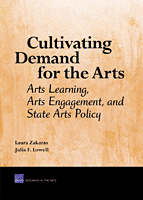CAA News Today
Report on Arts Education and Funding Published
posted by Christopher Howard — Sep 09, 2008
 Policymakers have underestimated the critical role of arts learning in supporting a vibrant nonprofit cultural sector, according to a RAND Corporation report just published. The study, written by Laura Zakaras and Julia F. Lowell and entitled Cultivating Demand for the Arts: Arts Learning, Arts Engagement, and State Arts Policy, was commissioned by the Wallace Foundation and conducted by RAND.
Policymakers have underestimated the critical role of arts learning in supporting a vibrant nonprofit cultural sector, according to a RAND Corporation report just published. The study, written by Laura Zakaras and Julia F. Lowell and entitled Cultivating Demand for the Arts: Arts Learning, Arts Engagement, and State Arts Policy, was commissioned by the Wallace Foundation and conducted by RAND.
Despite decades of effort to make high-quality works of art available to Americans, demand for the arts has failed to keep pace with supply. Audiences for classical music, jazz, opera, theater, and the visual arts have declined as a percentage of the population, and the percentage of these audiences age thirty and younger has fallen even more.
“For decades, public funding of the arts has focused on building supply and expanding access to the arts, but it has neglected the cultivation of audiences capable of appreciating the arts,” said the coauthor Laura Zakaras, an arts researcher at RAND. “If we are not teaching the young how to engage with works of art, they are not likely to become involved in the arts as adults.”
Calling on evidence that experiencing and studying the arts in childhood increase the likelihood of arts participation later in life, the study recommends policymakers in both the arts and education to devote greater attention to cultivating demand for the arts by supporting more and better arts education.
At the public school level, researchers note, arts content standards have been almost universally mandated by the states and are broadening teaching practices, but state, local, and district policies are not providing the resources or time in the school day to implement these standards. In fact, there is evidence that high-stakes standardized testing has led to reduced class time for the arts and humanities in the past five years, according to the study. Arts organizations and colleges have been helpful in complementing school-based arts education, but it is not enough to fill the void.
Analyzing grant-making data, researchers show that state arts agencies, which have historically focused on providing grants to arts organizations, have directed less than 10 percent of their grants over the last twenty years toward activities that target arts learning. In most states, grants are not part of a comprehensive strategy to promote youth or adult arts learning.
However, some state arts agencies are bucking this trend. Rhode Island and New Jersey, for example, have forged relationships with their state departments of education, other state agencies, and members of the arts community to develop comprehensive statewide plans for improving arts education in public schools.
In New Jersey, the state’s arts agency helped develop a survey of arts education that has raised awareness of the inadequacy of its provision in the schools. Concerned residents are now pushing for the adoption of a number of new policies, including inclusion of per-pupil arts spending in New Jersey’s Comparative Spending Guide for public schools. In Rhode Island, the state arts agency was instrumental in successful efforts to adopt a standards-based high school graduation requirement in the arts.
Based on these findings, the authors recommend that state arts agencies and policymakers gauge how well their states are doing by conducting surveys of arts education; developing specific high school graduation requirements in the arts; recognizing and publicizing arts learning programs considered exceptional by experts in the field; and advocating for changes in state policy that increase the amount and breadth of arts learning opportunities. According to the authors, a healthy demand for the arts is critical to a vibrant nonprofit arts sector. Policies that focus on supporting the supply of the arts and broadening access to the arts are not sufficient for building that demand.


